The work of designer and metalworker, Mary Williams (1869-1951)
A recent auction acquisition took an unexpected twist at the end of 2022. I purchased what I thought were several stunning items in repousse copper by the Fivemiletown Class from Ireland. The work of the Class is quite distinctive so I was certain of a link and, thanks to some background history from the seller, I was able to piece together a very interesting story.
A lot has been written about the designer and metalworker John Williams. He is best remembered for being one of the two earliest metalworkers at the Guild of Handicraft but he was also a keen teacher working with both the Newton School of Metal Work and the Fivemiletown Class before eventually becoming head of the art department at the Northampton Institute in Finsbury.
Much less is known about John’s younger sister, Mary. She was two years younger than John but clearly followed in his footsteps as a designer and maker of art metalwork. Between 1901 and 1911 she was working alongside another sister, Ann (Annie), as full time art metalworkers in London.1,2 She never married and described herself as a retired metal chaser in 1939.3 Very little is known about Mary’s contribution and like so many of the female designers and craftspeople of the time she is heavily overlooked in favour of her male counterparts. It is disappointing to think that her work remains largely unknown and the metalwork she designed and made may never be correctly attributed to her.
We know that Mary was also involved the Fivemiletown Class in Ireland and provided them with designs, including a design for an altar cross that was exhibited in 1899. Like John, Mary also visited Ireland in the 1890s.4 She exhibited some of her metalwork in Ireland during an exhibition of Arts and Crafts Industries work held by the founder of the Fivemiletown Class, Mary Montgomery, in 1896.5 John Williams was unable to travel to Ireland in the late 1890s due to other commitments but Mary made the trip over from London to continue classes in 1897, 1898 and 1899.6 The only documented design produced by the School by Mary appeared in the Studio in 1899.7 The piece was made by a metalworker from the Fivemiletown Class and the style is noticeably similar to her brothers with broad leaf foliate patterns on a tapering twin handled vase.
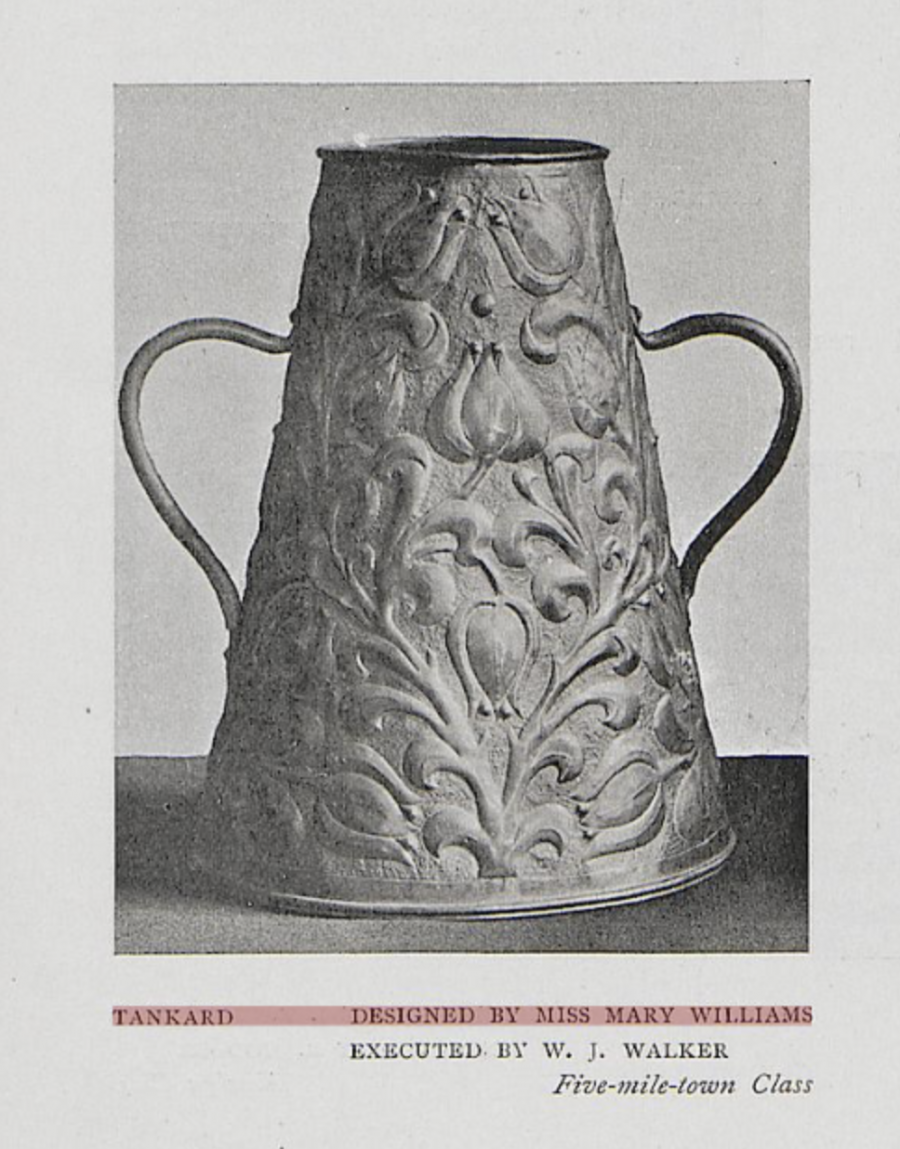
Copper tankard designed by Mary Williams and illustrated in The Studio, 1899
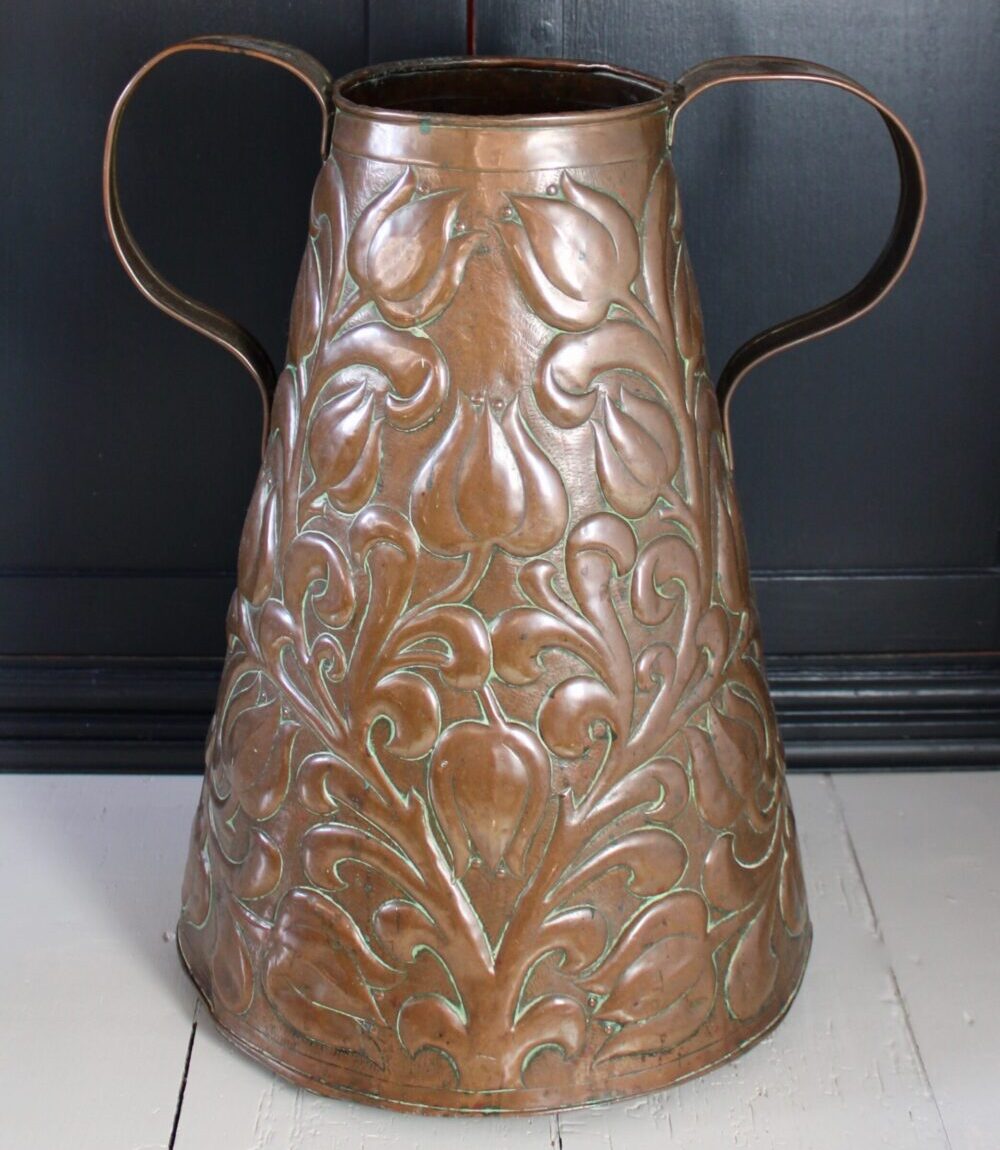
A large copper tankard with a repousse design by Mary Williams which was illustrated in The Studio, 1899. Attributed to the Fivemiletown Class (Private Collection).
Mary’s involvement with the Newton School of Metal Work is not well documented. The School’s full time tutor, Albert Prime, talked about a designer called Mary Williams and so we can be confident that Mary was also involved with the School. A fender exhibited at the 1897 Home Arts and Industries Exhibition and illustrated by The Studio, was designed by “M & J. Williams” suggesting that brother and sister collaborated on designs for the Newton School.8
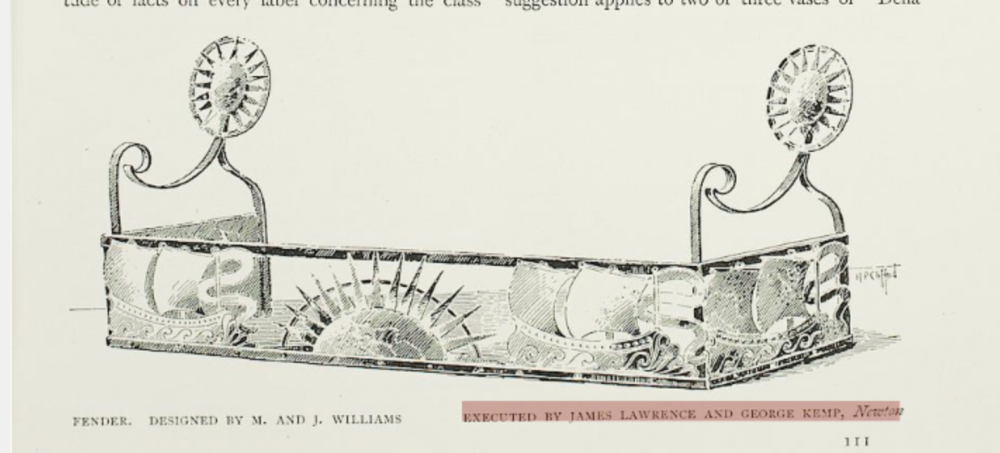
A fender designed by both John and Mary Williams. Illustrated in The Studio in 1897.
A copper repousse mirror made by the School in 1907 is fortunately marked “Designed by M. Williams” which suggests that Mary’s involvement with the School lasted for a least a decade.
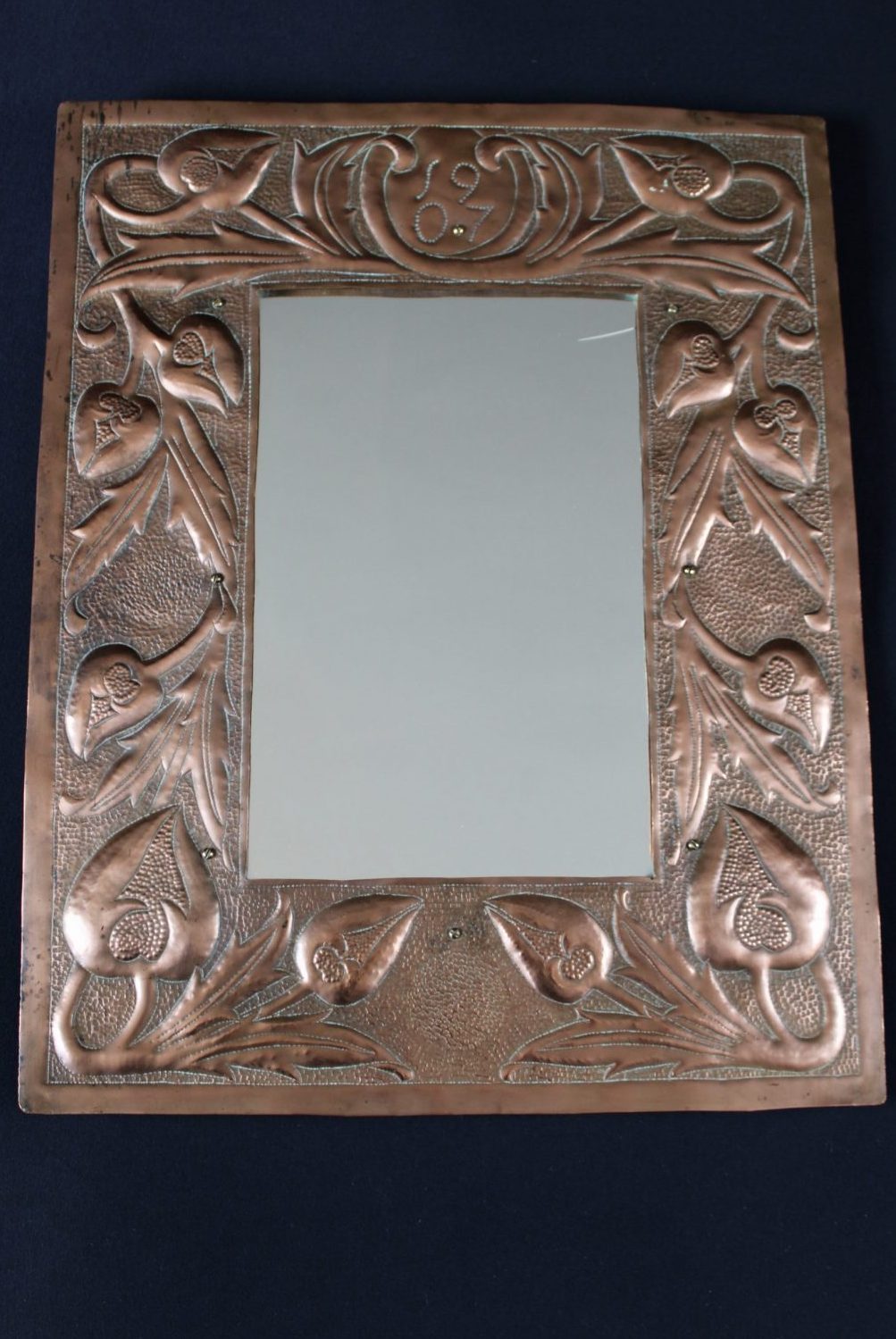
Repousse copper mirror designed by Mary Williams and made by G. Newling at the Newton Metal Work School in 1907. (Private Collection)
There are very few mentions of Mary and her sister Ann in periodicals of the day. They were both members of the Society of Women Artists’. The Society of Women Artists (SWA), which still exists, is a British art body dedicated to celebrating and promoting fine art created by women. It was founded as the Society of Female Artists (SFA) in about 1855, offering women artists the opportunity to exhibit and sell their works. Annual exhibitions have been held in London since 1857, with some wartime interruptions.
The first mention of the Williams’ family is from a newspaper article in The Shetland Times in March of 1899.9 It stated that, “The latest “show” of women’s work was that made by the Society of Women Artists in Suffolk Street, Pall Mall. The talented Williams’ family was en evidence with clever metalwork from which I selected a handsome plaque for illustration herewith”. In the same year The Queen newspaper illustrated some items exhibited at the same exhibition. This included a copper jardinière by Mary Williams.
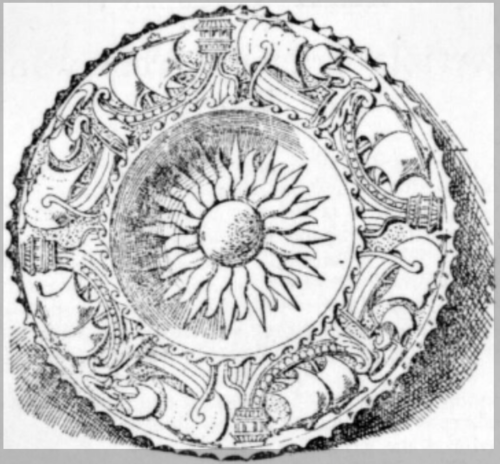
Plaque illustrated in The Shetland Times, 1899. Designed by Annie Williams
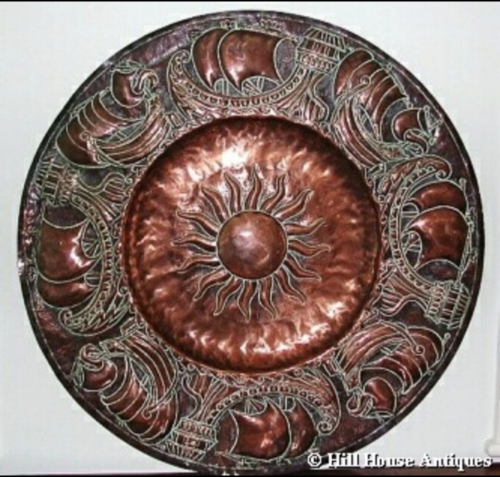
Example of a charger likely designed by Annie Williams, circa 1900 (Image used courtesy of Hill House Antiques)
The Williams sisters were mentioned in a 1904 article in the Arts and Crafts Magazine. The article stated “Shown at the Society of Woman Artists’ exhibition not particularly strong show of hammered metal-work we liked best the clock-face by Annie Williams, illustrated herewith, and a copper tea-tray designed and executed by Helen Smith. Worthy of mention, also, was a brass lock-plate by Mary Williams”.10
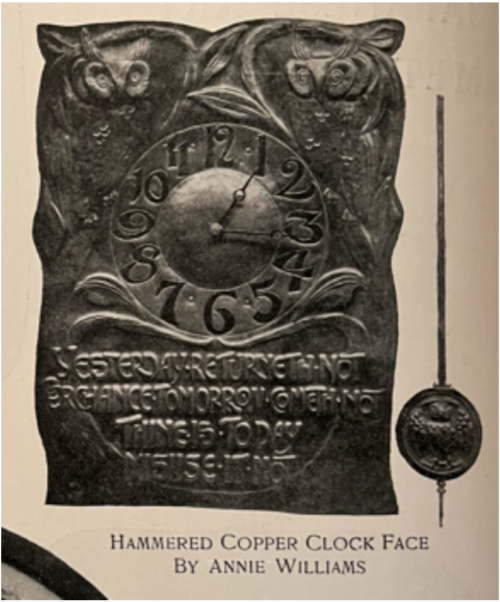
Clock face by Annie Williams shown in the Arts & Crafts Magazine Vol 1 and 2, 1904.
In November of 2022 a number of pieces came up for auction that I felt had to have come from the Fivemiletown Class in Ireland. I was fortunate enough to be put in touch with the seller of the respective Lots and, although not quite what I expected, I was along the right lines.
There were a number of design characteristics that looked very like the work of the Fivemiletown Class. The repousse copper firescreen stands on semi circular scrolled feet that were a unique design feature of the Class. The shape of the frame, the pierced repousse screen and the riveted construction are again typical when compared to other Fivemiletown designs.
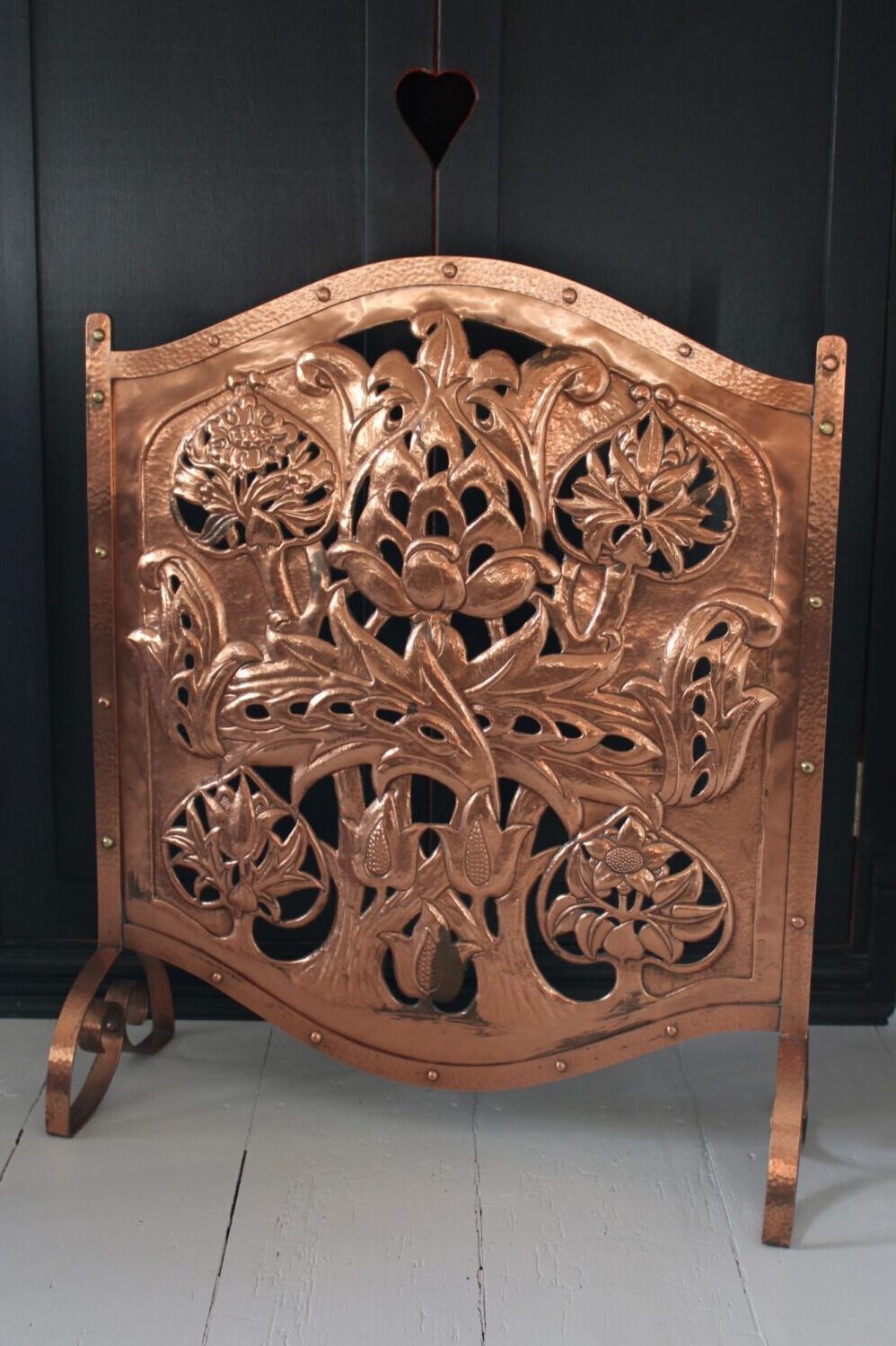
Pierced repousse copper firesecreen
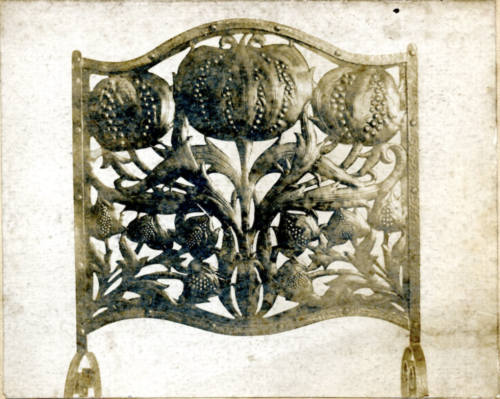
Image of a Fivemiletown Class firescreen designed by John Williams (Private Collection)
The twin handled copper vase with repousse design is also very characteristic of the work of the Fivemiletown Class. Although similar designs were used by the Newton School of Metal Work, the crispness of the repousse work and the gauge of copper is more like the work of the Irish class.
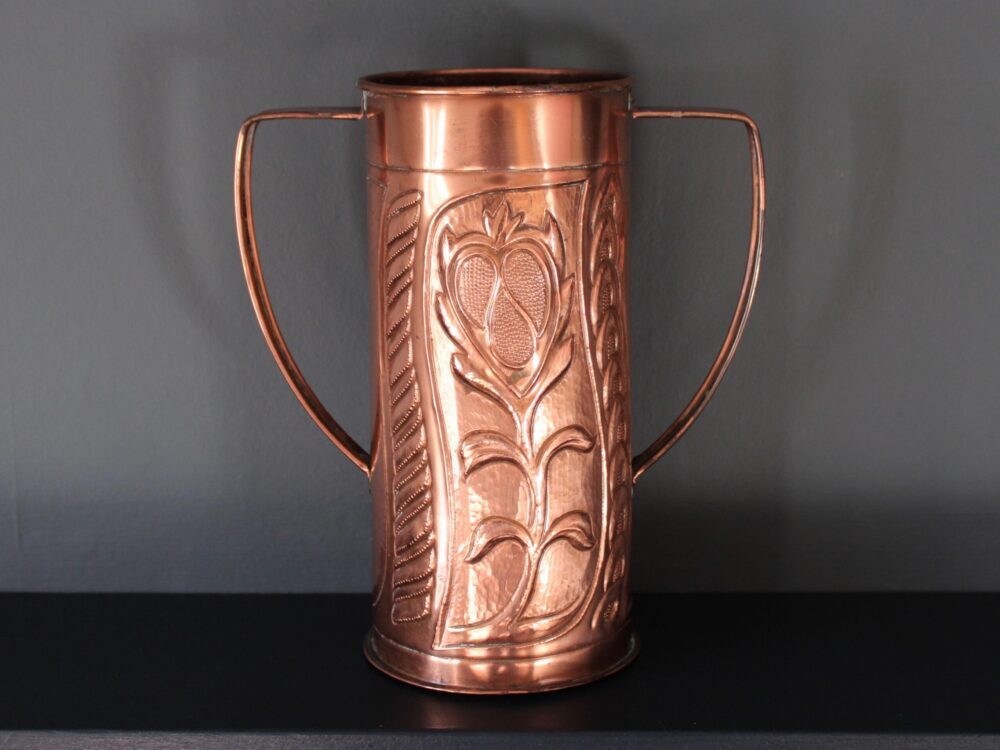
Repousse copper twin handled vase
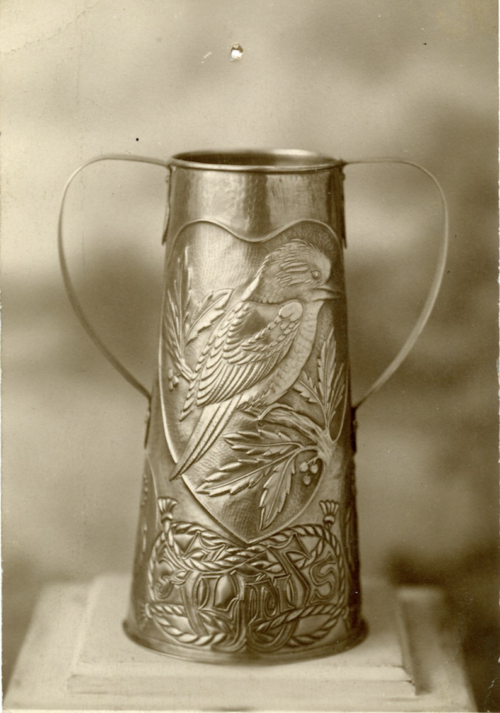
A very high quality twin handled vase made circa 1920 by known Fivemiletown worker, Patrick Roche (Private Collection).
A set of three planters also look very like similar designs by the Fivemiletown workers and the trivet and dish feel very Celtic much like many of the designs created by the Williams’s for the Class.
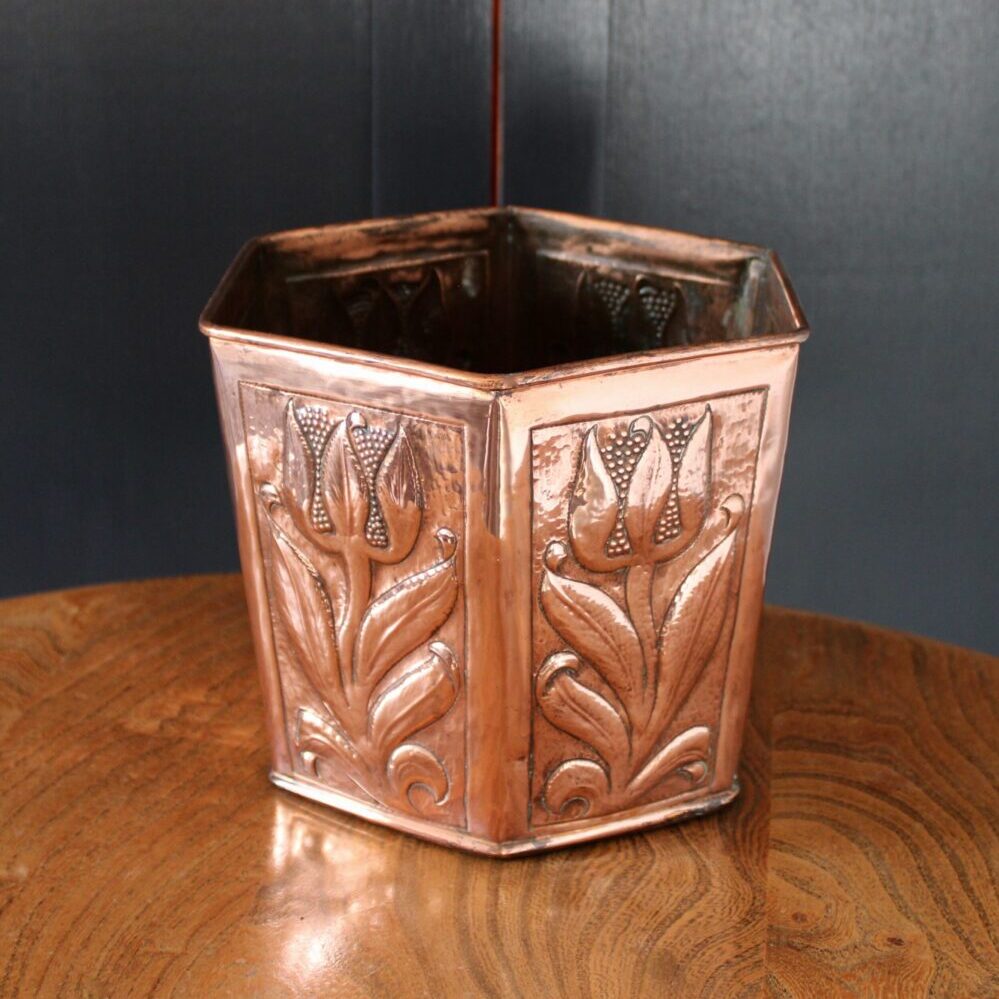
One of a set of three repousse copper planters
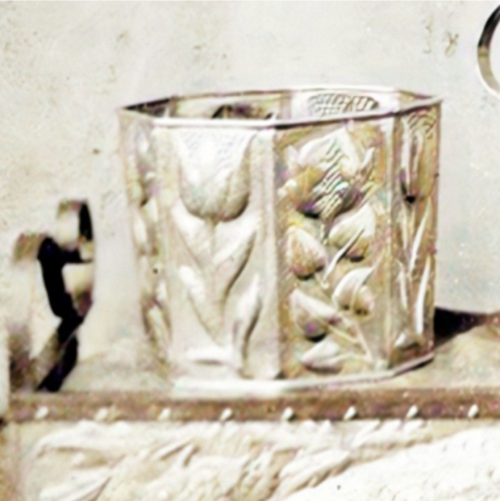
A planter taken from an image showing a selection of metalwork by the Fivemiletown Class, circa 1900 (Private Collection).
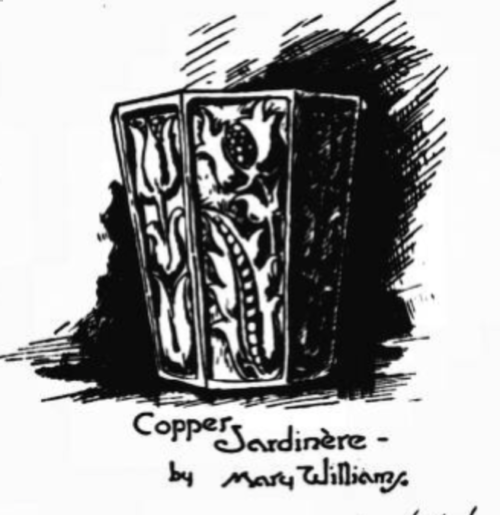
A copper jardinière by Mary Williams. Illustrated in The Queen, February 1899.
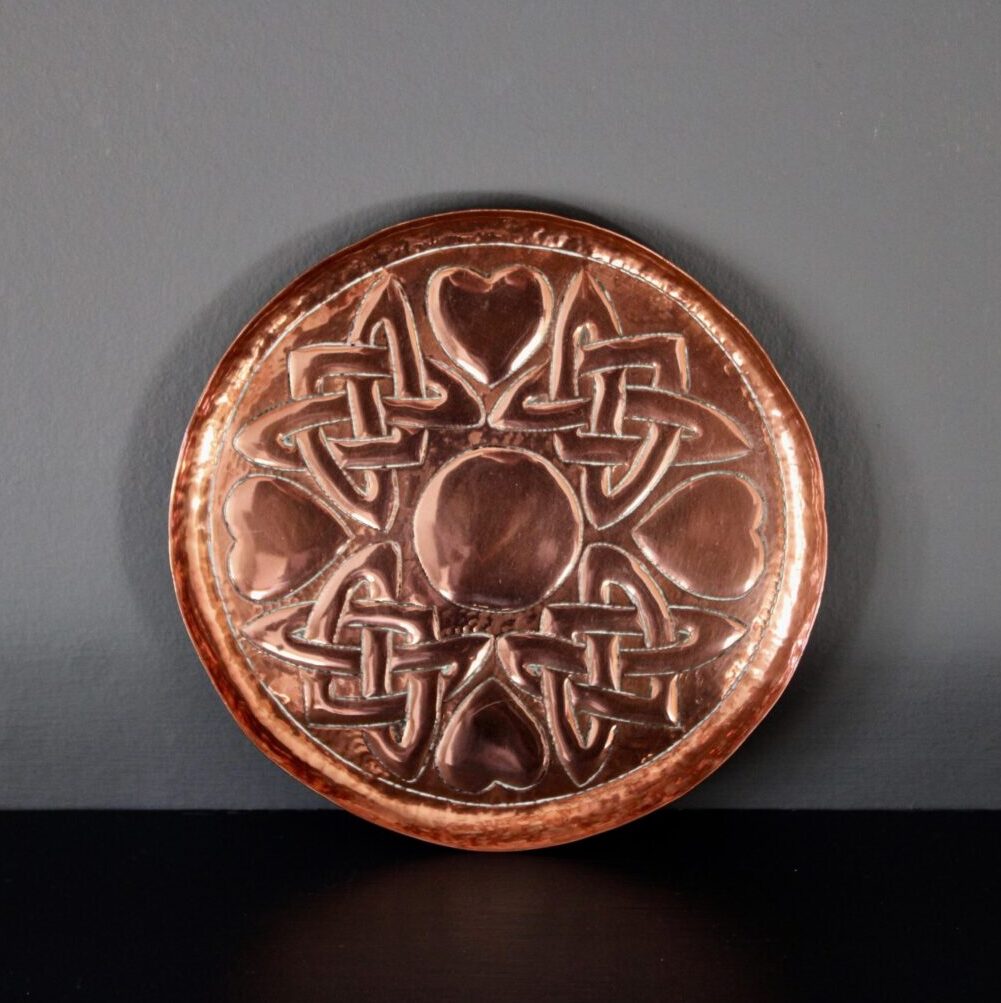
A repousse copper dish
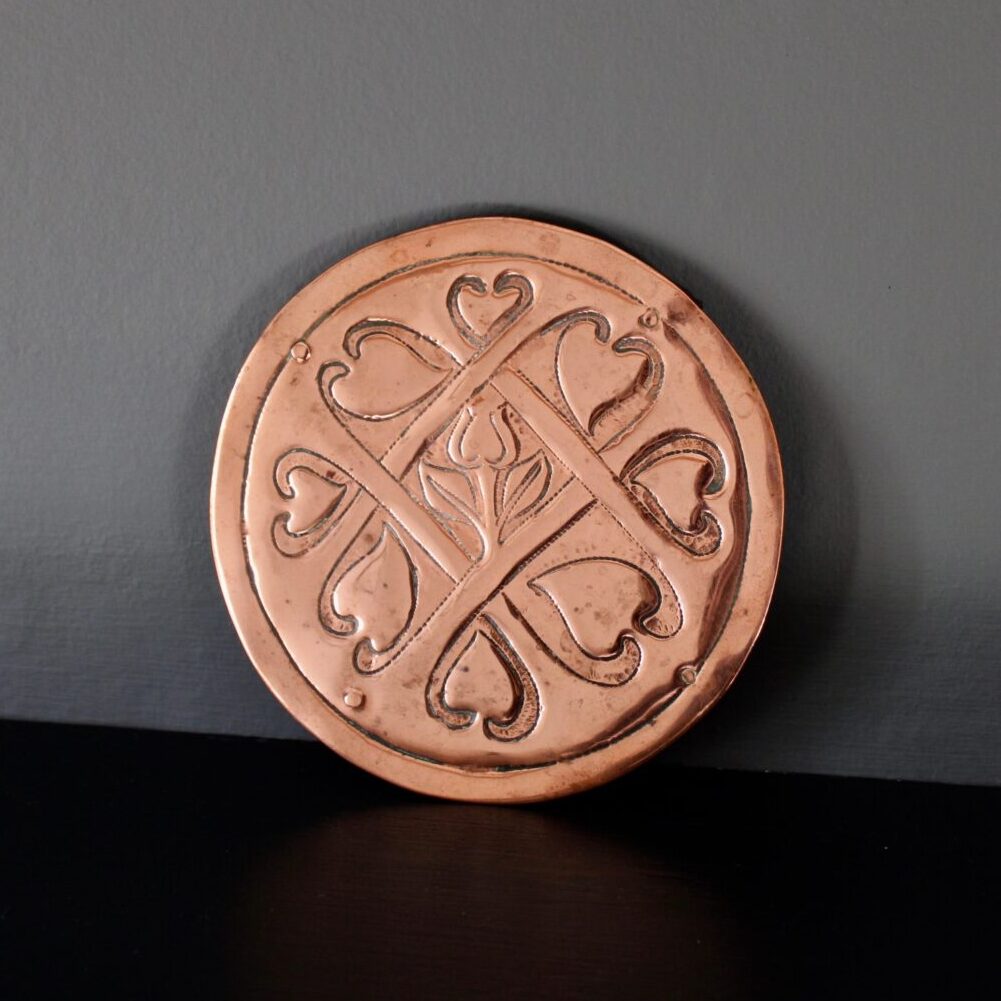
A repousse copper trivet or tea pot stand
The final two pieces are a large copper charger and an enormous copper tray. The charger has a repousse design of repeating peacocks. Peacocks were a common motif used by the Williams’s in Fivemiletown Class designs. The tray is probably the largest I have seen by an Arts and Crafts maker and was likely an exhibition piece.
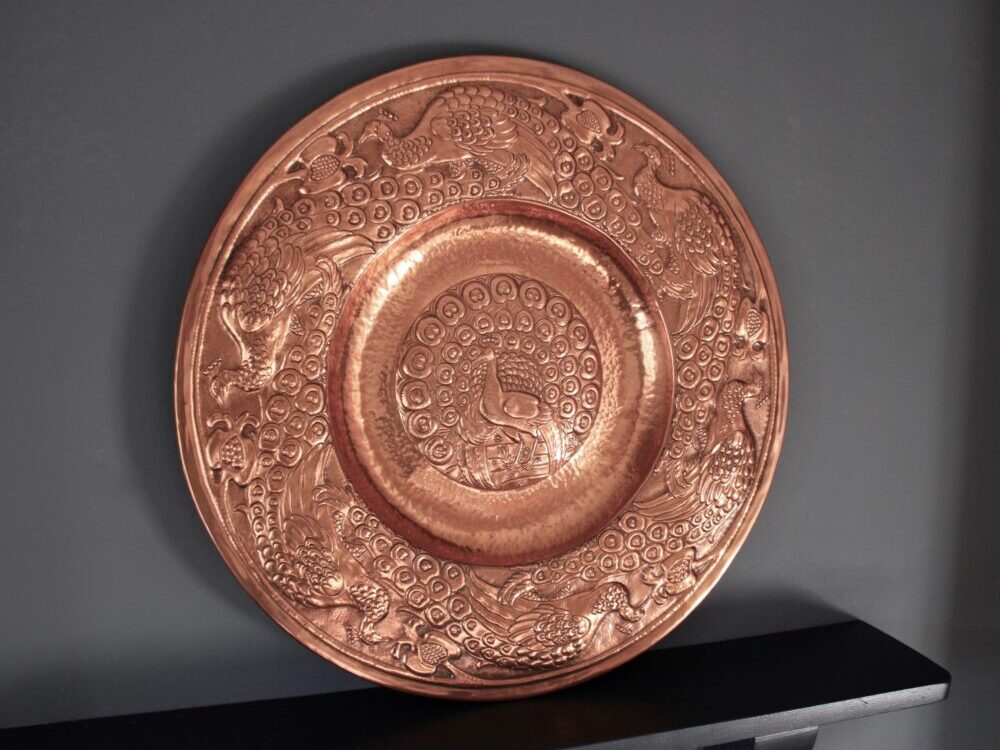
A repousse copper charger with peacock decoration
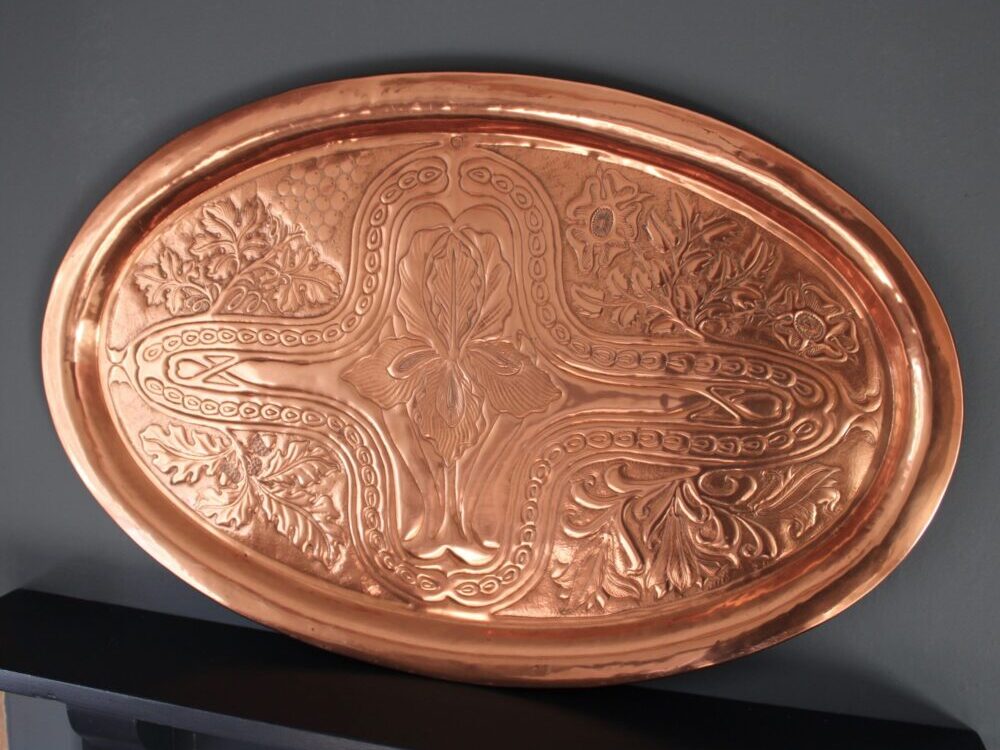
A large repousse copper tray
The items of metalwork all come from the same family and are believed to have been made by Charles Harmer and his father, Charles Harmer. Both men had worked for a family business, Charles Harmer and Sons Ltd. The factory occupied two town houses at 29-31 Danbury Street in Islington, London. The business was a sheet metalwork company that mostly made X-ray viewers.
So where was the link to the Fivemiletown Class?
The family very kindly contacted a previous work foreman who had worked at the company for over 50 years. Now in his 90’s, he held the key to solving this puzzle. He recalled that a lady called Miss Williams rented a basement room at 31 Danbury Street and she was the artist that created all the designs for that were then made by the two Charles’s. He believed this was all happening from 1890 through until about 1925.
A quick check of the census confirms that the Harmer family were indeed living at 29 Danbury Street, Islington, from 1891 to 1901.11,12 The house went on to become location of their business while the family had moved to live in Muswell Hill in 1911.13 The head of the family, Charles Harmer and his son, Thomas Charles Harmer are both listed as either tin plate workers or metal plate workers.
Now it all made sense, the Miss Williams has to be Mary Williams who was also producing similar designs for the Fivemiletown Class during this period. We already know that Mary taught the metalworkers over in Ireland and it seems likely that she was also running classes in London at the time. Mary was likely using the basement as a workshop or for teaching her metalworking classes. Around this time she was living at 15 Canonbury Street in Islington, which was a short walk away from Danbury Street.2
I’m confident the items bought at the auction are designed by Mary Williams. The skill level required to make some of these pieces was very high and Charles Harmer and his son must have spent many years learning repousse techniques to make these stunning items which thankfully stayed in the family until now.
As ever, it is fantastic to give pieces back a little bit of their history.
Footnote: Further discussions with another member of the family have suggested that the items were actually made Miss Williams and purchased, possibly even commissioned, by the family. It’s always hard to get an accurate picture after so many years but this to me makes sense as the quality of the repousse work on these pieces is exceptional.
1 – 1901 England census for Mary Rachel Williams
2 – 1911 England census for Mary Rachel Williams
3 – 1939 England and Wales register for Mary Rachel Williams
4 – The Arts and Crafts Movement in Ireland, Paul Larmour, 1992
5 – Tyrone Constitution, 18th September 1896
6 – The Fermanagh Herald, 18th May 1912
7 – The Studio: An Illustrated Magazine of Fine and Applied Art,. 1899
8 – The Studio: An Illustrated Magazine of Fine and Applied Art, Volume 11. 1897
9 – The Shetland Times, 25th March 1899
10 – Arts & Crafts Magazine Volume 1 and 2, 1904
11- 1891 England census for Charles Harmer
12 – 1901 England census for Charles Harmer
13 – 1911 England census for Charles Harmer